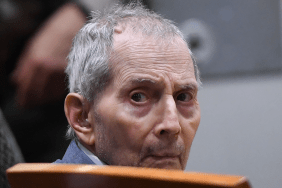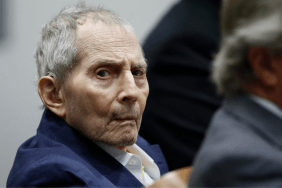
P presumably like most everyone else, I knew of HBO’s new six-part documentary series “The Jinx: The Life and Deaths of Robert Durst“, but hadn’t watched a single episode until being lured into the intrigue after its subject, Robert Durst, was arrested on Sunday, March 15, only hours before the sixth and final episode was to air with promises of a bombshell revelation. The show enjoyed a nearly 80% increase in viewership for that final episode, averaging 802,000 viewers for its initial airing at 8 PM. I didn’t watch on Sunday, instead I pored over all 4.5 hours over the course of Monday afternoon and evening, just so I could begin scouring the news reports that were flooding the Internet.
You needn’t look far when it comes to opinion pieces on both the documentary and Durst. Durst is suspected of murdering his wife, Kathie Durst, in 1982, the death of close friend Susan Berman in 2000 and actually admitted to killing and dismembering his next door neighbor, Morris Black in 2001. “The Jinx”, directed by Andrew Jarecki, explores Durst’s ability to avoid prison, a murder conviction in the case of Black and still, to this day, hasn’t been convicted in connection with his wife’s disappearance or Berman’s death, though he was arrested in New Orleans on March 15 in connection with Berman’s death.
According to a report at the New York Times, Durst is believed to have left Houston on March 10, headed for New Orleans. Investigators involved in the case said they feared the renewed attention brought by “The Jinx” would lead him to try to flee the country, which is what ultimately resulted in his arrest.
So what’s next? Well, that’s where we begin to look at the documentary in connection with the case as you don’t have one with out the other.

In the death of Susan Berman a hand-written note was sent to the Beverly Hills Police in block lettering. The note misspelled “BEVERLEY” and used the word “CADAVER” to describe the dead body that could be found at Berman’s address. While Durst is shown this note, and denies writing it, in the fifth episode of “The Jinx”, an envelope is revealed with similar block lettering and the same misspelling of “BEVERLEY”. Durst later admits he sent and was responsible for writing the address on the front of the envelope, but still maintains he did not write the “cadaver” note, though a forensic document examiner tells the filmmakers the tics in the note’s handwriting “are unique to one person and only one person.”
The sixth episode’s “bombshell” reveal is audio of Durst following his final interview with Jarecki (see bottom of this post), alone in the bathroom after denying the handwriting on the “cadaver” note was his. “There it is. You’re caught,” he’s heard saying before adding, “What the hell did I do? Killed them all, of course.”
Damning stuff, but is it enough to be considered a confession and is it admissable? A lawyer speaking with The New York Times says what we’re all thinking, which is Durst had an expectation of privacy when he was alone in the bathroom. There’s also this weird question of the documentary’s timeline, which is quite possibly the only poor aspect of the entire production.
Considering the length of time between Kathie Durst’s disappearance and Morris Black’s death, it’s somewhat strange how infrequently Jarecki points out just when exactly his interviews with Durst are taking place, when he obtained the envelope with Durst’s hand-writing and when exactly the bathroom audio was recorded. Perhaps that’s due to the fudging of the story’s timeline. Let’s have a look.
The final two episodes are where the documentary is as much about the filmmakers’ and their work as it is about Durst as the two seem to collide. We know the second interview with Durst took place in April 2012, but Jarecki says they didn’t come across the audio of Durst in the bathroom until June 12, 2014. That’s all fine and dandy, but key to finally landing that interview, at least as presented in the documentary, is Durst’s August 2013 arrest after violating an order of protection from his brother Douglas. Hmmm, those dates don’t really mesh.
The dates also come into question when we learn Jarecki and his team began speaking to Los Angeles investigators in early 2013 after discovering the envelope, but that would mean it was more than a year after discovering the letter in the first place (I’m still not sure when exactly the letter was discovered). There is talk of “journalistic privilege” and “possibly jeopardizing the material’s admissibility in court”, but without an explicit look at the timeline, it becomes a bit hazy when attempting to determine how much was manipulated for the sake of drama in these final episodes and how much happened as they told it.
Of course, this is to look at the particulars of the situation as someone who isn’t trained in the law and is merely speculating out of sheer fascination for Durst and Jarecki’s documentary. This all goes to the credit of the filmmakers and their ability to frame the story in such a way that it called on us to question whether or not Durst was actually guilty.
How willing are you to believe in coincidence? How many times can the same person be in the wrong place at the wrong time? Let’s say you believe he murdered his wife, where is the body? Where is the proof? Would he really fly from New York to northern California, drive down to Beverly Hills to execute one of his best and only friends and then fly home?
These questions bubble to the surface all while we know he killed Morris Black and chopped his body up and threw it into the Bay, not to forget went back to retrieve Black’s head, which was never actually recovered. To that point, there were moments in the documentary that had me wondering why certain questions weren’t asked.
During the trial, Durst refers to the gun that shot Morris Black as “my gun“, not “his gun”, which it presumably would have been considering the scene Durst describes. The court also never asks Durst where Black’s head is, or at least we never see the question being asked or answered and Jarecki doesn’t ask either. And yet, the burden of proof is on those of us that would believe Durst is guilty of all three crimes, but can that be proven?
The fact law enforcement had to move on Durst out of fear he would go on the run following the sixth episode of “The Jinx” may result in a trial moving forward before they had all their evidence prepared. Would it surprise anyone that watched “The Jinx” if Durst goes free once again? These are the wonderfully compelling intricacies of what Jarecki’s documentary posed.
However, back to that question of “What’s next?” One thing is for certain, we won’t be hearing from Jarecki for some time as he released the following statement only yesterday:
“Given that we are likely to be called as witnesses in any case law enforcement may decide to bring against Robert Durst, it is not appropriate for us to comment further on these pending matters.”
So we wait…









